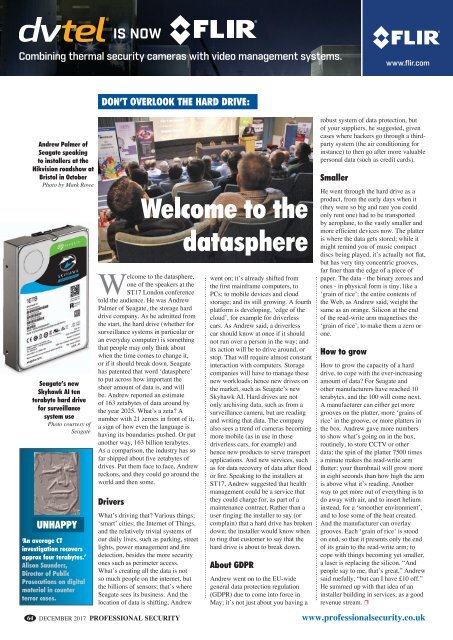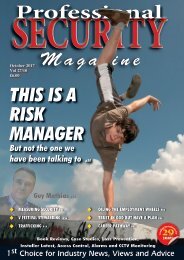Draft27-12
You also want an ePaper? Increase the reach of your titles
YUMPU automatically turns print PDFs into web optimized ePapers that Google loves.
IS NOW<br />
Combining thermal security cameras with video management systems.<br />
www.flir.com<br />
Untitled-20 1 18/02/16 10:18<br />
64<br />
Andrew Palmer of<br />
Seagate speaking<br />
to installers at the<br />
Hikvision roadshow at<br />
Bristol in October<br />
Photo by Mark Rowe<br />
Seagate’s new<br />
Skyhawk AI ten<br />
terabyte hard drive<br />
for surveillance<br />
system use<br />
Photo courtesy of<br />
Seagate<br />
UNHAPPY<br />
‘An average CT<br />
investigation recovers<br />
approx four terabytes.’<br />
Alison Saunders,<br />
Director of Public<br />
Prosecutions on digital<br />
material in counter<br />
terror cases.<br />
don’t overlook the hard drive:<br />
Welcome to the datasphere,<br />
one of the speakers at the<br />
ST17 London conference<br />
told the audience. He was Andrew<br />
Palmer of Seagate, the storage hard<br />
drive company. As he admitted from<br />
the start, the hard drive (whether for<br />
surveillance systems in particular or<br />
an everyday computer) is something<br />
that people may only think about<br />
when the time comes to change it,<br />
or if it should break down. Seagate<br />
has patented that word ‘datasphere’<br />
to put across how important the<br />
sheer amount of data is, and will<br />
be. Andrew reported an estimate<br />
of 163 zetabytes of data around by<br />
the year 2025. What’s a zeta? A<br />
number with 21 zeroes in front of it,<br />
a sign of how even the language is<br />
having its boundaries pushed. Or put<br />
another way, 163 billion terabytes.<br />
As a comparison, the industry has so<br />
far shipped about five zetabytes of<br />
drives. Put them face to face, Andrew<br />
reckons, and they could go around the<br />
world and then some.<br />
Drivers<br />
What’s driving that? Various things;<br />
‘smart’ cities; the Internet of Things,<br />
and the relatively trivial systems of<br />
our daily lives, such as parking, street<br />
lights, power management and fire<br />
detection, besides the more security<br />
ones such as perimeter access.<br />
What’s creating all the data is not<br />
so much people on the internet, but<br />
the billions of sensors; that’s where<br />
Seagate sees its business. And the<br />
location of data is shifting, Andrew<br />
DECEMBER 2017 PROFESSIONAL SECURITY<br />
Welcome to the<br />
datasphere<br />
went on; it’s already shifted from<br />
the first mainframe computers, to<br />
PCs; to mobile devices and cloud<br />
storage; and its still growing. A fourth<br />
platform is developing, ‘edge of the<br />
cloud’, for example for driverless<br />
cars. As Andrew said, a driverless<br />
car should know at once if it should<br />
not run over a person in the way; and<br />
its action will be to drive around, or<br />
stop. That will require almost constant<br />
interaction with computers. Storage<br />
companies will have to manage these<br />
new workloads; hence new drives on<br />
the market, such as Seagate’s new<br />
Skyhawk AI. Hard drives are not<br />
only archiving data, such as from a<br />
surveillance camera, but are reading<br />
and writing that data. The company<br />
also sees a trend of cameras becoming<br />
more mobile (as in use in those<br />
driverless cars, for example) and<br />
hence new products to serve transport<br />
applications. And new services, such<br />
as for data recovery of data after flood<br />
or fire. Speaking to the installers at<br />
ST17, Andrew suggested that health<br />
management could be a service that<br />
they could charge for, as part of a<br />
maintenance contract. Rather than a<br />
user ringing the installer to say (or<br />
complain) that a hard drive has broken<br />
down; the installer would know when<br />
to ring that customer to say that the<br />
hard drive is about to break down.<br />
About GDPR<br />
Andrew went on to the EU-wide<br />
general data protection regulation<br />
(GDPR) due to come into force in<br />
May; it’s not just about you having a<br />
robust system of data protection, but<br />
of your suppliers, he suggested, given<br />
cases where hackers go through a thirdparty<br />
system (the air conditioning for<br />
instance) to then go after more valuable<br />
personal data (such as credit cards).<br />
Smaller<br />
He went through the hard drive as a<br />
product, from the early days when it<br />
(they were so big and rare you could<br />
only rent one) had to be transported<br />
by aeroplane, to the vastly smaller and<br />
more efficient devices now. The platter<br />
is where the data gets stored; while it<br />
might remind you of music compact<br />
discs being played, it’s actually not flat,<br />
but has very tiny concentric grooves,<br />
far finer than the edge of a piece of<br />
paper. The data - the binary zeroes and<br />
ones - in physical form is tiny, like a<br />
‘grain of rice’; the entire contents of<br />
the Web, as Andrew said, weight the<br />
same as an orange. Silicon at the end<br />
of the read-write arm magnetises the<br />
‘grain of rice’, to make them a zero or<br />
one.<br />
How to grow<br />
How to grow the capacity of a hard<br />
drive, to cope with the ever-increasing<br />
amount of data? For Seagate and<br />
other manufacturers have reached 10<br />
terabytes, and the 100 will come next.<br />
A manufacturer can either get more<br />
grooves on the platter, more ‘grains of<br />
rice’ in the groove, or more platters in<br />
the box. Andrew gave more numbers<br />
to show what’s going on in the box,<br />
routinely, to store CCTV or other<br />
data; the spin of the platter 7500 times<br />
a minute makes the read-write arm<br />
flutter; your thumbnail will grow more<br />
in eight seconds than how high the arm<br />
is above what it’s reading. Another<br />
way to get more out of everything is to<br />
do away with air, and to insert helium<br />
instead, for a ‘smoother environment’,<br />
and to lose some of the heat created.<br />
And the manufacturer can overlay<br />
grooves. Each ‘grain of rice’ is stood<br />
on end, so that it presents only the end<br />
of its grain to the read-write arm; to<br />
cope with things becoming yet smaller,<br />
a laser is replacing the silicon. “And<br />
people say to me, that’s great,” Andrew<br />
said ruefully, “but can I have £10 off.”<br />
He summed up with that idea of an<br />
installer building in services, as a good<br />
revenue stream. p<br />
www.professionalsecurity.co.uk<br />
p64 Networks 27-<strong>12</strong>.indd 1 18/11/2017 <strong>12</strong>:<strong>12</strong>










